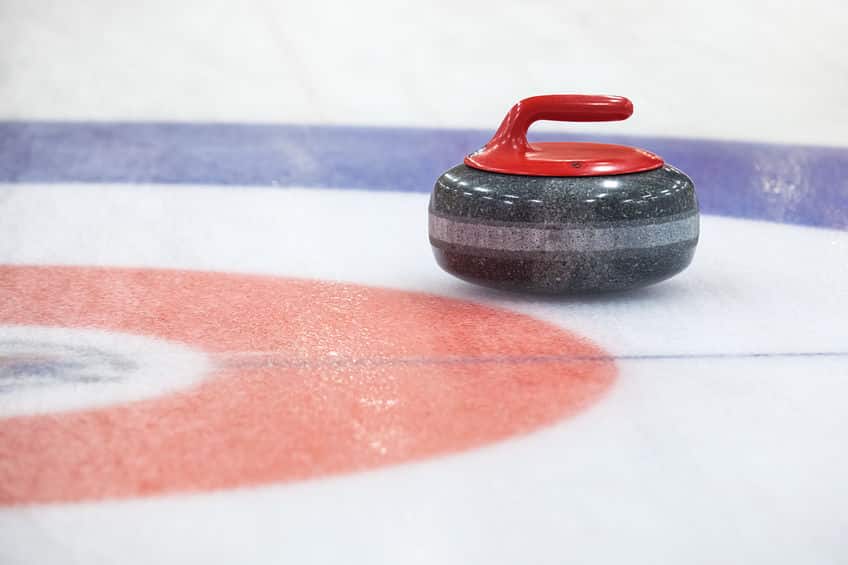By John Salak –
Talk about getting caught between a rock and a hard place. That’s what the sport of curling faces—or at least its image does. To the uninformed, it looks like a cross between bocce ball and bowling, complete with comfortable shoes and a decided absence of noticeable sweat. Of course, one of the biggest differences between bowling, bocce ball and curling is that curling is played on ice. The other big difference is that it’s a fully-fledged Olympic sport that casual viewers marvel at every four years.
Yeah, right, it is admittedly hard to imagine curlers as hardcore international athletes. Looks, however, can be deceiving and curling at its higher levels is definitely more physically demanding than it seems at first glance. It is also an activity on a casual level that is social, skillful and provides a decent workout.
Curling centers around one player sliding a 38-44 pound stone across a lane of ice 146-150 feet long, hoping that it will either end up in a scoring circle or knock an opponent’s stone out of the circle. As the stone slides down the ice, two other team members—wearing sensible shoes—frantically sweep the ice with brushes in hopes of helping the stone along to its desired destination.
Looks aside, it is also extremely popular. Curling can trace its roots back more than 500 years to Scotland and today it boasts over 1.5 million active players in Canada, the United States, Sweden, Norway, Switzerland and its native land.
The sport went from a curiosity of sorts to gain some serious chops in 1998 when it became an Olympic activity with 16 nations competing since then in men’s, women’s and mixed doubles competition. Its rising prominence also has been helped along by a growing legion of celebrity fans such as George Clooney, Bruce Springsteen, Toby Keith and NFL football player Vernon Davis, among others.
Olympics, 40-pound rocks, endorsements by The Boss, among others, still not convincing enough to convince that masses that curling is a “real” sport? Fair enough. But Ann Swisshelm, the “lead” on the 2014 U.S. Women’s Olympic Curling Team, would disagree.
She told The Cut a few years back that everything from sliding the stone, called “the lunge”, to cleaning the ice as it slides down the lane is demanding. “That lunge, the slide — that really takes flexibility and balance, stamina and strength. But the real trick is recovering after sweeping in order to throw that stone,” she said. “That is without a doubt the most physically grueling component of the game. You’re torquing yourself sideways, you’re shuffling up and down the ice at varying rates of speed. You do it over and over and over again, and it can be pretty exhausting.” The skipper of Great Britain’s Women’s Curling Team couldn’t agree more. Ann Muirhead reports that in the course of a game up to a mile a high-paced sweeping is involved, which, in turn, means many of her players need to be and are as ripped as a beach volleyball player.
It can also burn some calories, let alone put a demand on a range of muscle groups. At a high level of competition, curlers burn between 600-700 calories an hour, which is comparable to skating boarding competitors and about three times as many calories as the average person burns up pushing around their snowblower.
All this—working with heavy stones, ice, throwing, lunging and sweeping all at a competitive pace—should require some form of structured training, correct? Absolutely. In fact, in recent years as curling has become more popular and internationally competitive, the days of the causal slip and slide and then let’s have a butt and a brew, have been replaced with extremely structured nutritional and physical regimens.
Prior to the competitive season, for example, the U.S. Men’s Curling finds itself in the gym six days a week. Three days are dedicated to weights—squats, cleans and deadlifts—and three days are for cardio. They also spend a couple of hours each day working on their throwing and sweeping techniques.
The trainers even design cardio workouts to mirrors the sweeping demands during a competition. “We will do a lot of 20 (seconds) on and 40 off, or 30 and 30, or 40 and 20 to simulate sessions for the sweepers, to get them used to that high heart-rate cardio activity,” team Head Athletic Trainer Brian McWilliams told Men’s Journal.
Admittedly, casual curlers on the thousands of local community teams probably don’t get this obsessed in preparing for their weekend matches, which gives hope to anyone wanting to get involved in a little winter fun. But casual curlers still take their sport seriously. And the curling demands and workouts high-level athletes face undoubtedly give the sport and its sensible shoes all sorts of new respect.














